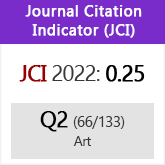First conclusions concerning the cult and iconography of St. James the Great in Rome
DOI:
https://doi.org/10.3989/aearte.2010.v83.i329.410Keywords:
Saint James the Great, Rome, Churches, Historical maps of Rome, Historical guides of Rome, Art, Cult, IconographyAbstract
This article deals with the artistic and devotional topography associated with St. James the Great in the city of Rome based on a study of the churches and pilgrim hospitals under his patronage. An examination of the principal bibliographical and documental sources, especially those concerned with topography and iconography, has led to two aspects that converge: one is chronological, and has allowed us to date the foundation, disappearance, destruction or change of patronage of the churches, confirming a strong development of the cult of Saint James between the Jubilee Year 1300 and the end of the 15th century, and subsequently a rapid decline throughout the 16th century into the first decades of the 17th century; the second aspect is geographical and demonstrates the importance of the basilica of St. Peter, its relics and its pilgrims in the early development of the cult of St. James and then, later, the connection between those hospitals and churches and the pilgrimage to the main Roman basilicas. To this is added a study of the works of art, preserved or lost, relics, processions and other liturgical expressions, completing a study which aims at presenting and overall picture of the subject.
Downloads
Download data is not yet available.
Downloads
Published
2010-03-30
How to Cite
Vázquez Santos, R. (2010). First conclusions concerning the cult and iconography of St. James the Great in Rome. Archivo Español De Arte, 83(329), 1–22. https://doi.org/10.3989/aearte.2010.v83.i329.410
Issue
Section
Articles
License
Copyright (c) 2010 Consejo Superior de Investigaciones Científicas (CSIC)

This work is licensed under a Creative Commons Attribution 4.0 International License.
© CSIC. Manuscripts published in both the printed and online versions of this Journal are the property of Consejo Superior de Investigaciones Científicas, and quoting this source is a requirement for any partial or full reproduction.All contents of this electronic edition, except where otherwise noted, are distributed under a “Creative Commons Attribution 4.0 International” (CC BY 4.0) License. You may read here the basic information and the legal text of the license. The indication of the CC BY 4.0 License must be expressly stated in this way when necessary.
Self-archiving in repositories, personal webpages or similar, of any version other than the published by the Editor, is not allowed.















